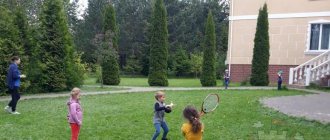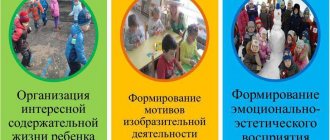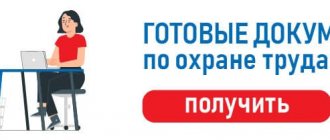Working with children before bed - goals and methods
Sleep is necessary to restore the baby's physiological and mental balance . According to sanitary and hygienic standards, its duration for children under 5 years old is 2 hours, for children under 7 years old - 1–1.5 hours.
Sleep is the basis of a child's health
In order for a child’s sleep to become a physiological habit, it is necessary to strictly follow the daily routine, down to every minute. Then, by the time the daytime rest begins, the child will be ready for it.
Many preschoolers have a thousand reasons not to fall asleep, so methodical work before daytime rest plays an important role. Its goals are:
- relaxation of children (reduction of anxiety and muscle tension),
- restoration of the normal state of the nervous system,
- relief of psycho-emotional stress,
- accelerating the process of falling asleep by creating a safe and comfortable environment.
To achieve his goals, the nap organizer faces a number of tasks that he has to solve every day:
- Preparing the room for rest. The best sleeping pill is cool air. The rest room should be cleaned and ventilated. In the hot season, it is recommended to open windows for ventilation (in the absence of drafts!) and while babies sleep.
- Monitoring children's readiness for sleep. Adults make sure that all children go to the toilet, wash themselves, wash their hands/feet, and change into clothes that are comfortable for sleeping.
- Creating a calm and relaxed atmosphere suitable for sleep.
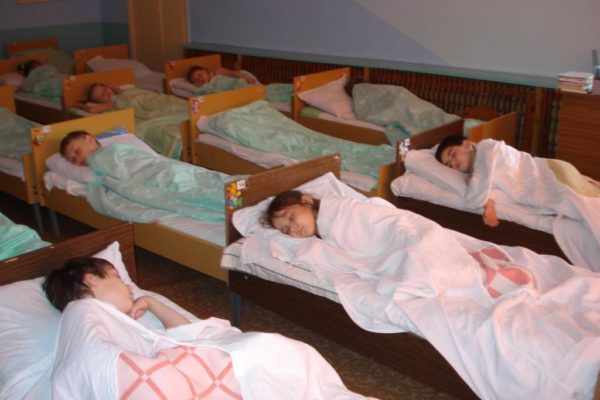
The room where children sleep must be ventilated in advance.
Methodological organization of preparing children for bed
To achieve the assigned tasks, the teacher:
- determines a list of quiet games before going to bed,
- selects an appropriate calm musical accompaniment (for no more than 10–15 minutes), accompanied by a decrease in the tempo of speech, timbre and tonality of the voice,
- conducts a set of breathing exercises to improve the well-being of children,
- periodically organizes conversations with children about the importance of daytime sleep (this technique is more relevant for older and preparatory groups),
- makes a selection of fairy tales and stories on suitable topics.
These techniques can be used in combination, but for children of the first and second junior groups, who due to age get tired faster, and therefore need rest more than others, it is enough to turn on background music after lunch (while carrying out hygiene procedures, changing clothes) and reading fairy tales. For children in the middle group we add breathing exercises. In addition to their beneficial effect on the respiratory system, they also help develop correct sound pronunciation. This is a very important task for this age. This gymnastics is carried out 20–30 minutes after lunch. Older children can play a little quiet games before starting hygiene procedures.
Many psychologists deny the importance of daytime sleep, since such a regime, strictly observed in kindergarten, suppresses the individuality of children who do not want to sleep.
How to create favorable conditions for falling asleep
It is very important in what environment babies fall asleep. Set up for sleep:
- muffled light,
- closed curtains or blinds,
- pastel, calm colors of walls and ceilings,
- Fresh air.
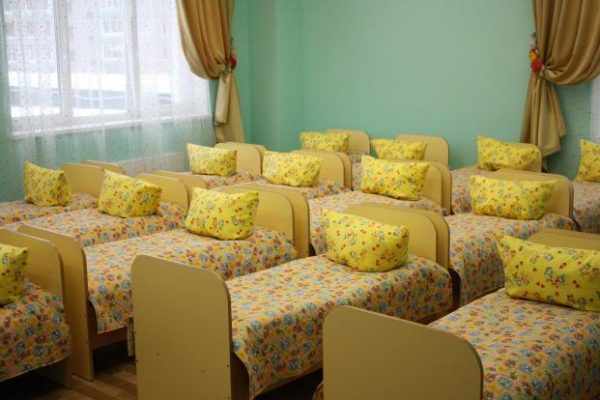
Pastel colors of the environment, cleanliness and fresh air are the key to sweet sleep for babies
Stages of work before bed: time plan
There are 3 stages of organizing daytime sleep.
- Preparation (15–20 minutes).
- Relaxation (5–7 minutes).
- Sleep (1–2 hours).
Preparation
The longest and most important stage. At the first stage, children play calm games.
Games for the first and second junior groups
Quiet games with objects:
- "Magic bag" The teacher invites the kids to put their pen into a bag of small toys and, without taking it out, guess what it is.
- “Pick up a figure.” Kids receive a set of geometric shapes (3-4 pieces) and blank stencils. Task: name the figurine and place it in the appropriate hole.
- Dominoes (lotto). If the kids are already familiar with team games, then you can offer them dominoes, in which animals are depicted on all the dice. Task: players need to find among their chips the one that will continue the line on the table.
Games for the middle group
Games for the middle group may include tasks for quick wits and ingenuity (but not only):
- Folding given figures from mosaic elements occupies a leading place in the card index of games before bedtime for children 4–5 years old.
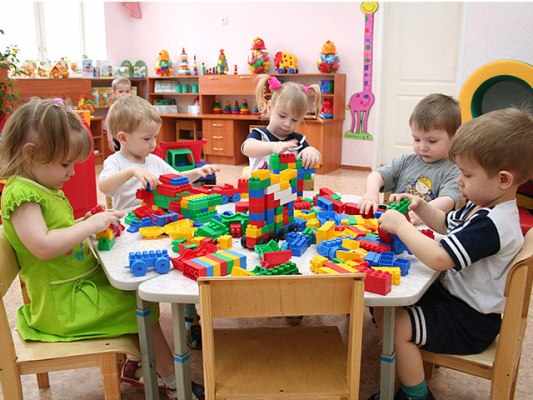
Mosaics and construction sets not only train coordination, develop the child’s thinking processes, but also perfectly relax
- "Sharp eye". We show the children a jar or bowl. Their task is to estimate the diameter of the container opening and cut out a lid of the appropriate size from cardboard. The one whose cap matches exactly wins.
- "Repetition." The teacher names a topic (usually close to the one that was in the lesson before lunch), on which the children select words. The kids complete the task one by one, and when they say their word, they repeat those that were voiced earlier.
Games for senior and preparatory groups
These can also be motor games, after which you can tell a fairy tale or do breathing exercises:
- “Grandma went to the market and bought...” The presenter says: “Grandma went to the market and bought a meat grinder” - he imitates the movement of the meat grinder with his hand. The next participant says the same phrase, but instead of a meat grinder he names something of his own (for example, a coffee grinder, a sewing machine). After the arms, movements for the legs are called (the main thing is that the “purchase” can be shown with a simple movement). Imitating the movement of the named object, the child does not stop turning the meat grinder. The point is to do all the movements at the same time.
- "This is my nose." The kids sit in a circle. One touches his chin and says, “This is my nose.” His neighbor touches his nose but says, “It’s my chin.” The point is to talk and show different parts of the body (you can limit yourself to one face or head).
- "King of Silence" One baby - the king - sits on a chair, the rest stand around him. The monarch points to any child and gestures to him. This is how he chooses his ministers. If the “minister” makes even the slightest noise along the way, he is eliminated. It’s the same with the king: if he makes a noise, then he is overthrown from the throne and put in this place the first minister, who reached the royal person silently.
It is advisable to involve all the children in the games.
Fairy tales
Children love fairy tales very much. And in younger groups, due to age-related slowness, there is no time left for games, so reading aloud is the best technique. Although older children will be happy to listen to the exciting story.
- "The Tale of the Deer Who Couldn't Sleep."
- Iris Review “How Tisha searched for sleep.”
- Andrey Prokofiev "Hare's Foot".
- "The Tale of the Rhino who Couldn't Sleep."
- Natalya Yashchenko “How the Striped Tiger Cub was looking for treasure”, etc.
Poems
At the preparation stage, after playing and reading fairy tales, children go to the toilet and carry out hygiene procedures: they wash their hands, in the summer - their feet, and wash themselves. The younger ones do this with the help of a teacher and an assistant teacher. Adults accompany all actions with poems (especially important for children, whose actions are better organized by such rhymes); older children recite them together with their teachers.
- Jump-jump, jump-jump, We'll sit down on the potty. We ate, we drank, we almost forgot about him! Obedient kids Do little things: A-a-a and pee-pee-pee. Just don't rush!
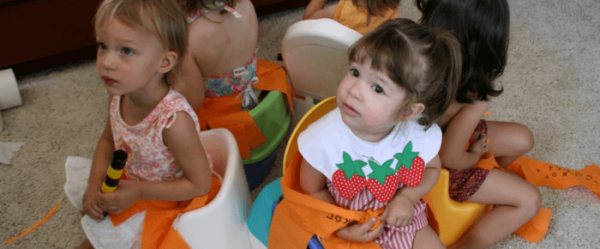
Preparing for bed in the younger group begins with putting the kids on the potties
- Good water! Help a little: Wash the kids’ dirty palms! You, a piece of soap, wash us without sparing, Our hands will become cleaner and whiter!
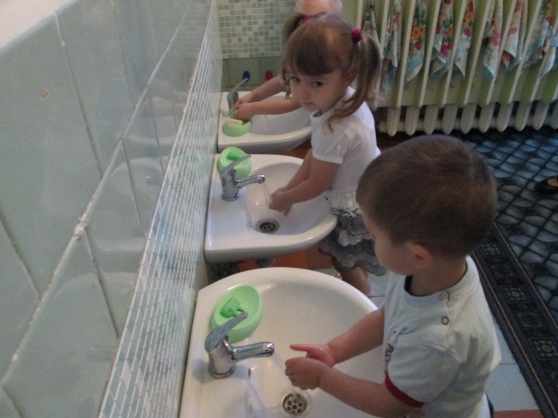
Hygiene is given special attention before bedtime
- Water, water, Wash my face, So that my eyes shine, So that my cheeks blush, So that my mouth laughs, So that my teeth bite.
Game situation
It's time for the kids to undress, fold their things and put on their pajamas. The process of undressing can be turned into a game “We are already quite big.”
Instructions:
- “Children, let's see if you have matured this day. First, we’ll tell you in what order you need to take off your clothes.”
- The children do it. Either everyone speaks in turn, or one person named by the teacher speaks.
- “Now we need to put things on the high chair.” Children do it, adults help.
- "Great! I see that you are already quite big. But you probably won’t be able to put on your pajamas without my help...” The children, spurred on by the excitement of the teacher’s doubts, get dressed.
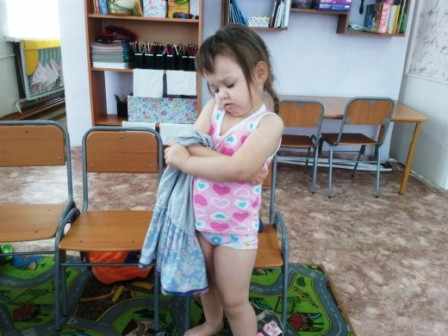
Creating game situations speeds up the process of undressing and dressing for bed
Alternatively, you can come up with a story about the Bella doll, which can’t remember in what order you need to take off your clothes: first the shoes, and then the dress, or vice versa? Many children, regardless of age, have difficulty keeping things in order. For such guys, you can use the story about Mitya, who after sleep was constantly dirty.
Instructions:
- “Children, look who came! This is Mitya, he is also going to bed. Oh, he’s upset for some reason and doesn’t want to go to bed... What happened? It turns out that Mitya is a very neat boy, but every time after sleep his clothes turn out to be dirty and wrinkled. And all because the boy, when undressing, does not fold his things, but crumples them. And he puts shoes on top.”
- “Let’s tell Mitya how to fold clothes.”
- Children talk. (It is advisable to take turns, after the teacher gives the floor. Otherwise, they will talk vying with each other).
- "Great! You said everything correctly, and now Mitya and I are going to bed.”
Relaxation
This stage is appropriate to carry out with calm music, which has a general calming effect. The best option is the sounds of nature (the noise of the forest, the murmur of a stream, etc.).
Breathing exercises
Before the kids go to bed, they are given 1-2 exercises (for the younger group), 2-3 for the middle, senior and preparatory groups.
"Rose and Dandelion"
Instructions:
- We stand up straight, imagine that we are holding a rose in our hand, and inhale its aroma.
- And in the other hand there is a dandelion. We blow on it, exhaling.
- Repeat 3-4 times.
"Breath"
- Quietly, quietly we will breathe, we will hear our hearts.
Instructions:
- The initial pose is standing, arms extended at the seams.
- We inhale through the nose until the air begins to expand the chest.
- We freeze for 4–5 seconds.
- We also exhale through the nose.
- Repeat 2-3 times.
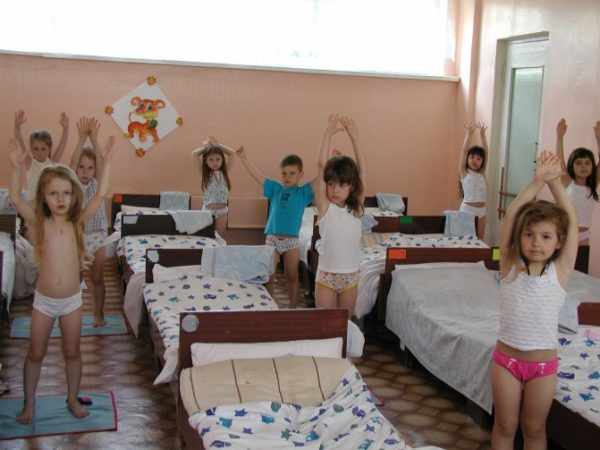
Breathing exercises help children relax
Games with rewards
Reward games can be used to encourage sleep in older children.
Table: games with encouragement for organizing sleep (fragment of the master class “Time to sleep, or how to organize sleep in kindergarten”)
| Option #1 | Before going to bed, the teacher tells the children that they are starting a competition “Who will fall asleep first.” After the sleepy hour, the teacher chooses the winners: 1st, 2nd and 3rd place - who, in turn, fell asleep earlier. The teacher singles out each winner by raising his hand and presents him with a medal. The medals are transferable; the next day other children can receive these medals. |
| Option No. 2 | Before going to bed, you can arrange one more trick. You can offer the children a condition: for the children who are the best at pretending so that the teacher (or character) thinks that they have fallen asleep, after a quiet hour there will be a surprise (at the teacher’s choice - for example, you can buy stickers, chips or other interesting things for children as a gift). inexpensive item). But pay attention to the fact that this will not be easy to do; you need to relax, lie down comfortably and close your eyes without opening them. Children will try to pretend and fall asleep. |
| Option #3 | Use a cumulative bonus system. We also choose winners - who fell asleep first, and collect tokens for each child during the week. At the end of the week, we count the number of tokens and reward the winners. |
| Quote by: Skovorodko E.V., teacher of the Municipal Budgetary Educational Institution “Sinekolodetskaya Elementary School-Kindergarten”. Reward games for sleep management | |
Middle group planning on the topic: World Thank You Day
PLANNING EDUCATIONAL WORK from 01/09/14 - 01/10/14.
middle group “Bells” Topic: World “Thank You” Day Purpose: to consolidate the rules of polite communication between children and peers and adults; develop coherent speech, remember and activate “kind, magic” words in speech; cultivate politeness in dealing with people. Open event: exhibition of children's works “Decorate a napkin” responsible: Rachkova O.N. Day of the week Mode Integration of educational areas Joint activities of adults and children, taking into account the integration of educational areas Organization of a developing environment for children’s independent activities (activity centers, all group rooms) Group, subgroup Individual Educational activities in special moments January 9 - Thursday Morning:
games, duty, individual work, errands, morning exercises, Cultural Hygiene Skills, breakfast, games Morning exercises. Duty. Articulation gymnastics. Conversation “Why do we say thank you?” Goal: remember polite words and explain their meaning. .Didactic game “One - many”. Purpose: to learn to form the plural of a noun. Develop the ability to recognize and name the seasons - Pasha, Vlad. Develop the ability to prepare your workplace and clean it after finishing classes. Independent activity in the isocenter: examination of illustrations of decorative paintings. Activities in the center of didactic games: “mosaic”, “puzzles”, “lotto”. Direct educational activity No. 1 Communication (Petrova, p. 31) Topic: “Celebration of politeness.” Goal: to clarify the rules of polite communication and master politeness formulas; develop memory, speech. Cultivate politeness towards peers and adults. No. 2 Application (Komarova, p. 34) Topic: “Decorate the napkin” Purpose: to teach children to make a pattern on a square, filling the middle and corners with elements; learn to cut a strip in half after folding it; strengthen the ability to hold scissors correctly. Games, preparation for a walk Walk: Observation of a cat Purpose: to consolidate the idea of the characteristic features of a cat. Labor activity Sweeping paths, collecting garbage. Goal: to cultivate hard work. Outdoor game “Cat and Mouse”, “Clouds and Sun”. Goal: to teach how to run easily, without bumping into each other, and how to navigate in space. Development of movements. Goal: to consolidate skills in jumping on two legs while moving forward - Alina, Anton. Continue to introduce children to the basic rules of behavior in kindergarten. Games with external materials - balls. Outdoor games at the request of children. Independent activity of children on the site - consideration of changes in nature. Returning from a walk, KNG, lunch, work before bed, reading pure sayings about winter. Goal: formation of correct sound pronunciation. Speak clearly - Danil, Vlad. Cultivate the habit of washing your hands with soap before eating. Examination of illustrations about winter in the center of fiction. Evening: Awakening gymnastics. Hardening procedures. Reading A. Barto’s poem “Thank you” goal: to learn to listen to the text and answer questions. The work assignment is to help the teacher repair books. Goal: to teach children to independently maintain order in the group. The use of antonym words in speech - Yulia K., Adelina. To develop children's interest and independence in choosing games. Role-playing game “At a doctor’s appointment.” Goal: to develop the ability to unite in a game, distribute roles (doctor, patient), and perform game actions. Games with a large constructor. Goal: learn to name and distinguish construction parts. procedures, Cultural Hygiene Skills, afternoon snack, independent games Children's activities, leisure, clubs individual work Walk Observation of clouds. Outdoor game "Hares and wolves". Goal: to teach children to move at the teacher’s command. Driving directions (left, right) - Roma, Katya. Rules of behavior on the street and in the area. Free games at the request of children. Games with external material. January 10 - Friday Morning: Morning exercises. Duty. Articulation gymnastics. Conversation “Polite words”. Goal: Remind children of polite words and their meaning. Didactic game “Who, where?” Purpose: to learn to coordinate a noun with an adjective in gender and number; repeat prepositions. Teach carefully, paint over a certain area of the drawing - Alina, Adelina. Strengthen the ability to water plants. Printed board games “Dominoes”, “Loto”. Drawing with wax crayons using templates. Goal: development of hand motor skills. Work in the nature center - watering indoor plants before the weekend. Direct educational activity No. 1 Physical education (according to the physical worker’s plan) Purpose: to exercise children in walking and running, stopping at the teacher’s signal; crawling on your stomach on a gymnastic bench, developing strength and agility; repeat the task of maintaining stable balance. No. 2 Music (according to the music worker’s plan) 16.05-16.25 Goal: to develop the ability to feel the character of music, recognize familiar works, express your impressions of what you listened to; to develop expressive singing skills, the ability to sing, drawling and moving; To develop the ability to move in pairs in a circle in dances and round dances. Walk: Games, observations, work, individual work, physical education and recreational work. Poplar observation. Goal: to introduce the characteristic features of poplar by which it can be distinguished from other trees. Labor activity – cleaning paths from snow. Goal: to cultivate hard work. Outdoor games "Find us". Goal: learn to navigate in space. "Owl." Goal: learn quickly, act on the teacher’s signal. Goal: improve walking technique with an extended step - Misha, Anton. Continue to cultivate neatness and the habit of taking care of your appearance. Independent activity of children in the area with outdoor materials (balls). Goal: to cultivate independence in organizing joint activities. Outdoor games at the request of children. Returning from a walk, Cultural Hygiene Skills, lunch, work before bed Compiling a story based on the plot picture “Guys playing snowballs.” Goal: development of coherent speech. Coordinate words in a sentence - Vlad. Situational conversation “How to play with toys.” Reviewing books in the fiction center. Evening: recreational and tempering Invigorating gymnastics. Hardening. Reading of O. Emelyanova’s poem “Polite Words.” Goal: learn to listen to the text of a poem and answer questions about the content. Labor assignment - cleaning toys in their places. Name verbs that characterize labor actions - Vlad L., Alina. Improve the skills of careful eating: take food little by little, chew it well, eat quietly. Role-playing game "Ride on the Bus." Goal: to develop the ability to unite in a game, distribute roles (driver, passengers), and perform game actions. Study of natural material - bump. Goal: to develop research activities. walk Observing the wind. Outdoor game “Run to me.” Goal: development of speed of movement. Help children collect toys in a basket. Learn to negotiate - Kirill, Misha. Reinforce the rules of communication with adults.
We recommend watching:
How to organize walks in the summer with children in a preschool educational institution Plan for the work of a circle in a kindergarten. Senior group Long-term work plan for the circle in the senior group Educational and methodological development “MACRAME. Learning the techniques of Italian weaving. Making cosmetics
Similar articles:
Long-term work plan on the topic: “Education of the fundamentals of safe behavior in preschool children” with children 6-7 years old
Environmental education in kindergarten
Active consultation for preschool teachers. Sensory education for preschoolers
Consultation for educators “Use of ICT in working with parents”
Learning English at a preschool educational institution
